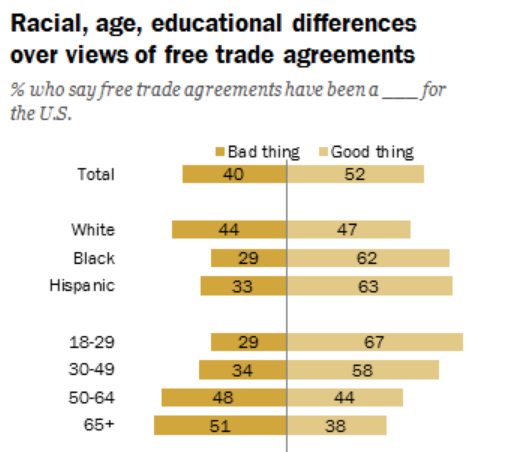Trade shocks and demand shocks
Paul Krugman has an excellent piece on the potential effects of an all out trade war. Likely Krugman, I think it unlikely that we actually go that far. My view is that before that happened, Trump would become frightened by a sharp fall in stocks and negotiate some sort of face saving deal where he could claim “victory”. (But when thinking about the stock market as a warning device, beware of the “circularity problem”. The stock market won’t warn Trump if it thinks he would heed their warning.)
Here I’d like to add one additional downside to a trade war, the way trade policy can (and has) interacted with monetary policy. A trade war might be even worse than Krugman estimates, if it leads to tighter monetary policy and falling NGDP.
You might think that Krugman has already factored falling NGDP into his estimate that a trade war could reduce RGDP by 2 to 3 percent. But unless I’m mistaken, he’s using a general equilibrium approach that abstracts from demand shocks. In other words, Krugman is showing that even in a world where the central bank stabilizes AD, a trade war could reduce RGDP by 2 to 3 percent by making the economy less efficient. But what if the central bank does not stabilize AD? In that case you might get an ordinary recession, piled on top of the adverse supply shock produced by a trade war. A recession slows the process of worker re-allocation into non-tradable sectors.
I can see two possible channels by which a trade war could reduce aggregate demand:
1. Imagine the central bank is targeting interest rates. If a trade war occurs, it’s likely that investment demand would fall, reducing the global equilibrium (i.e. “natural”) rate of interest. If the central bank does not reduce the policy rate as quickly as the natural rate is falling, that would lead to (effectively) tighter money and falling NGDP. (Think of this as a channel that operates if I’m wrong about monetary offset, and the Keynesians are right.)
2. Imagine the central bank is targeting inflation. If inflation is kept at 2% while RGDP growth is falling, then NGDP growth will also slow. (Here the problem can occur even if monetary offset is operative, as long as they target inflation, not NGDP.)
Keep in mind that slower NGDP growth is always a problem, even if there are other problems at the same time. Careful readers might recall that this is exactly what went wrong in 2008. The Fed adopted IOR to prevent its liquidity injections aimed at rescuing banking from spilling out into more aggregate demand, out of fear of inflation. They thought the banking crisis was “the real problem” when in fact there were two real problems, banking distress and falling NGDP. The falling NGDP led directly to higher unemployment, and also as a side effect made the other “real problem”, i.e. banking distress, even worse.
In my research on the Great Depression I found that the biggest problem caused by Smoot-Hawley was not that it reduced the efficiency of the US economy (the direct effects were modest), or even the retaliation from abroad. Rather the biggest problem was that Smoot-Hawley led to lower aggregate demand. This occurred either because of a fall in the Wicksellian equilibrium rate (very bad news under a gold standard), or because it reduced the likelihood of international monetary cooperation, or both.
BTW, this is no surprise:
Fears of a looming trade war between the U.S. and China are paradoxically helping to increase the value of the U.S. dollar in global currency markets, analysts say, potentially undercutting a Trump administration policy goal.
This is what happens when you have a president who hires crackpot economists who don’t even know that the current account deficit is a saving/investment issue, not an import/export issue.
HT: Tyler Cowen


